For the average chess player, the FIDE World Championship Circuit can be a tad bit confusing. Even top players have complained about how confusing it is.
The FIDE circuit stands as one of the most crucial qualification paths leading to the candidates’ tournaments, emphasizing its significance in the chess world.
In this article, we will highlight what the FIDE World Championship Circuit is all about and why it’s an important part of the candidates’ qualification cycle.
What is the FIDE World Championship?
As a refresher to the already detailed historical guide we have up, the FIDE World Championship is the most prestigious title event in chess.
The winner of which is recognized as the classical world chess champion, the strongest player under classical time control.
It’s important to state that the World Championship match is the final stage of a multi-year cycle involving qualification events like the World Cup, Grand Prix, FIDE circuits, etc.
What is the FIDE Circuit?
To put it plainly, it is a circuit comprising several top tournaments unified.
Purpose of the FIDE Circuit
Originally, the world championship cycle relied on a combination of zonal events, interzonal events, the World Cup, and Candidates Tournaments.
However, these formats often exclude many strong grandmasters and upcoming talents like yourself who are on the way to becoming a Grandmaster.
The FIDE circuit addresses this by
- Unifying top global tournaments into one coherent ranking system
- Rewards consistent performance across multiple events rather than reliance on a single spectacular result.
- Provide a transparent and inclusive pathway for elite players to qualify for the candidates
- Encourages organizers to host strong tournaments that attract international participation.
In short, it ensures that any players who perform at a high level throughout the year have a shot at playing for the World Chess Champion title.
Tournaments in the FIDE Circuit
Not all tournaments are part of the FIDE circuit.
The eligible tournaments, as highlighted in the FIDE World Championship Circuit regulations as approved by the FIDE council on 25 December 2024, include
- FIDE-rated standard tournaments (classical time control, over-the-board).
- World Rapid and Blitz Championships (2025 edition).
- Continental Rapid and Blitz Championships.
- Other strong FIDE-rated Rapid & Blitz tournaments (with stricter rating requirements).
Basic Requirements for Tournaments
Not every tournament is considered for the FIDE circuit. To count toward the Circuit, a tournament must:
- Finish within the official Circuit year (January 1–mid-December 2025, with slightly different cutoffs depending on type).
- Have at least 8 players (6 for elite double round-robin events with a Tournament Average Rating (TAR) of 2700+).
- Be of at least 7 rounds (minimum 4 for knockout events).
- Maintain a minimum strength: TAR of 2550 for most standard events and TAR of 2700 for blitz and rapid tournaments (this is to ensure that only very strong events count).
- Apply strict fair play protocols (anti-cheating measures).
- Feature international representation of players: at least 3 federations, with not more than 50% of top players from one country.
- Some exceptions apply to national championships and zonal events.
This ensures that tournaments included in the Circuit are of a genuinely high standard, giving legitimacy and competitiveness to the ranking system.
How are Circuit Points Counted?
This is where things get more interesting.
Unlike the standard FIDE Chess Ratings, the World Championship Circuit uses a points-based system based on placement in a tournament and the tournament strength itself.
Basic Points
Top finishing players earn points by finishing well in events:
Typically,
- 1st place: 11 points (if outright winner), 10 otherwise.
- 2nd place: 8 points.
- 3rd place: 7 points.
- …and so on, down to 8th place, which awards 2 points.
For round-robins, the top one-third of players score points.
While in knockout events, reaching at least the third round is required to be awarded any points.
Tournament Strength Factor
Raw points aren’t enough. Each tournament has a multiplier based on strength:
k = (TAR – 2500)÷100
So a tournament with a TAR of 2700 gives a multiplier of 2.0, doubling the points earned.
Special Adjustments
- The runner-up in the World Championship Match gets bonus points.
- World Cup quarterfinalists are treated as having finished 5th.
- Rapid and blitz events have reduced multipliers (since classical is prioritized).
- Smaller knockouts or events with multiple games per day also get adjusted.
This system rewards both performance and quality of opposition.
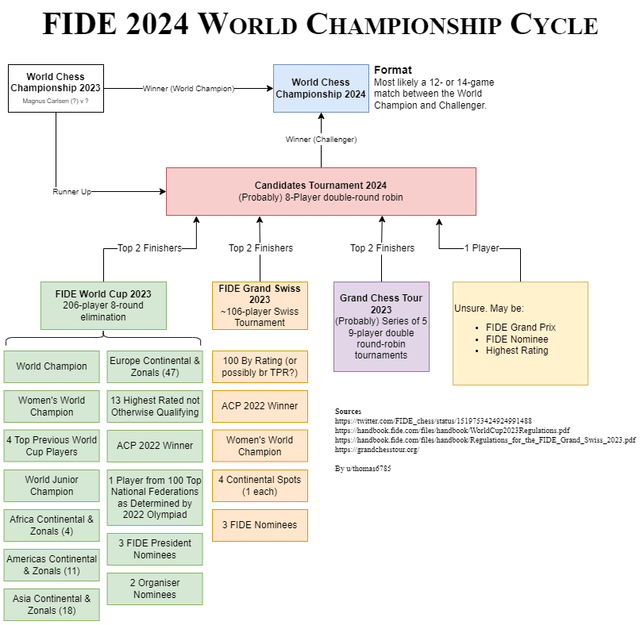
How the Last Circuit Functioned
The 2023 FIDE World Championship Circuit was the very first edition of this qualification system.
It ran from December 22, 2022, to December 30, 2023, and served as a direct path to the 2024 Candidates Tournament.
Fabiano Caruana emerged as the winner of the Circuit.
However, as he had secured qualification through the World Cup, the opportunity to compete in the Candidates Tournament was passed on to the runner-up, Gukesh Dommaraju.
Gukesh challenged Ding Liren for the title and made history as the youngest ever World Championship winner and challenger.
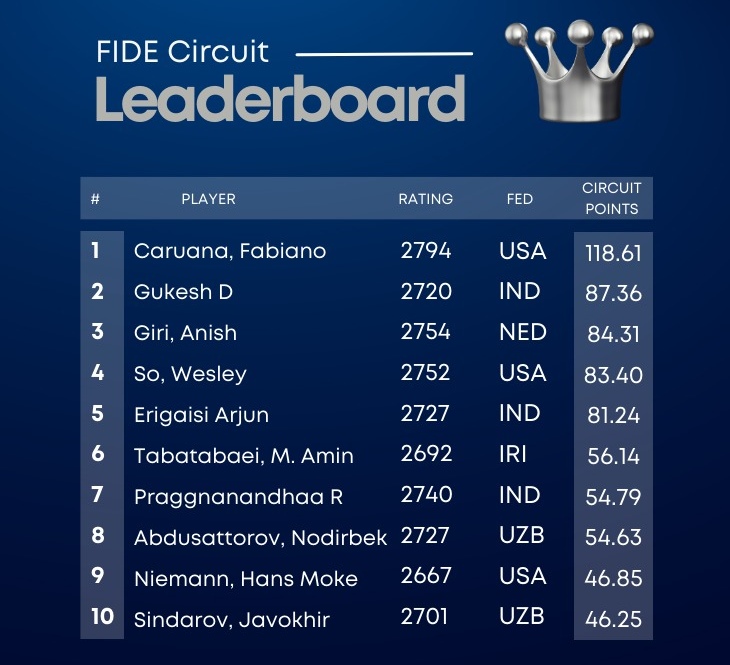
Lessons from the 2023 Edition
The first edition of the circuit revealed both the strengths and weaknesses.
The edition similarly favored closed elite events like the Grand Chess Tour more than open events.
Despite the flaws of the first edition, it was an immense success, as it favored players like Caruana and Gukesh.
They had proven themselves across multiple tournaments and were rewarded by the circuit format.
The current FIDE World Championship Circuit has been significantly refined based on the shortcomings identified in the first edition and incorporating recommendations from top players, resulting in a well-grounded and improved structure.

Criticism And Challenge
Although the circuit is well-received by most chess enthusiasts, it has also faced its fair share of controversy and challenges.
The challenges are reflected by varied responses within the chess community.
Regarding Complexity
Several chess enthusiasts and top players have expressed how complex the circuit is to understand and make sense of.
For example, Levon Aronian was a huge critic of the circuit system, sharing his opinion.
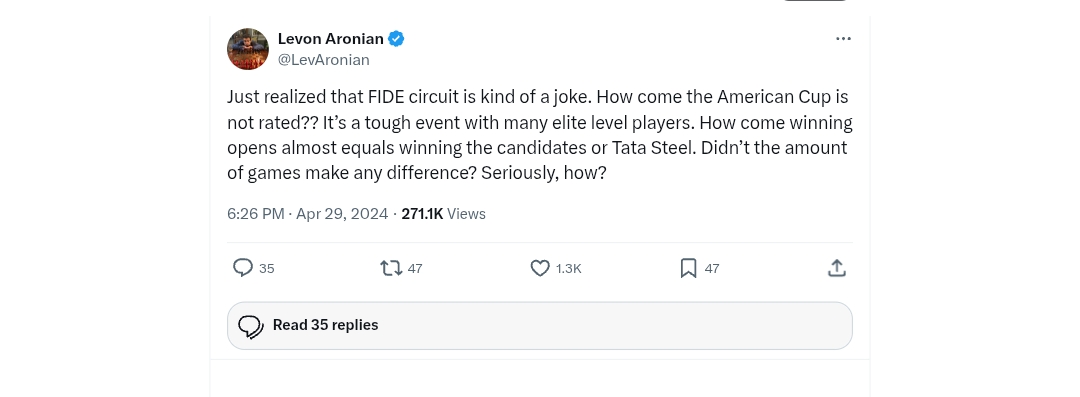
Anish Giri was also a popular critic and has shown displeasure about the circuit format.
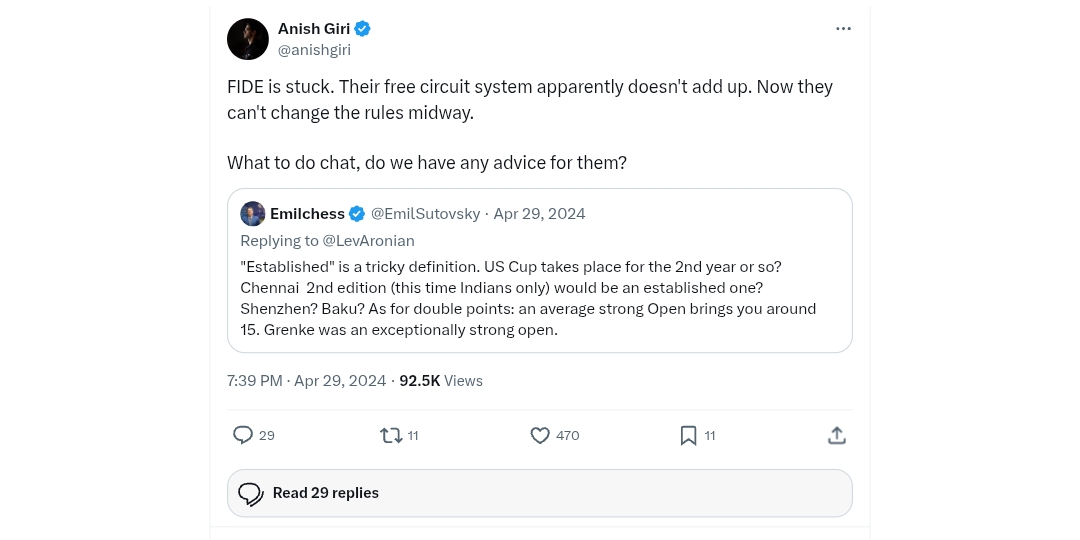
Inclusivity for the Average Top Players
Players from regions with fewer strong tournaments may have travel expense challenges.
No Women’s FIDE World Championship Circuits
This raises concerns about potential gender bias, as the absence of a women’s FIDE World Championship circuit may reflect a lack of equal opportunities in the chess world.
Similar to the women speaking out on women’s titles, this is possibly another case of segregation common to the chess world.
Final Words
A lot has been said about the World Championship FIDE Circuit, but one thing is for sure: it is here to stay.
If there’s anything that seems exciting about the circuit, it is the increased emphasis placed on it compared to the first edition.
In that edition, the circuit produced only one candidate spot; now it’s double that number.
As we anticipate the future of FIDE Circuits, we can only continue to appreciate the excitement that comes with the current format.
We also hope that it becomes easier to understand and track the Circuit activities.



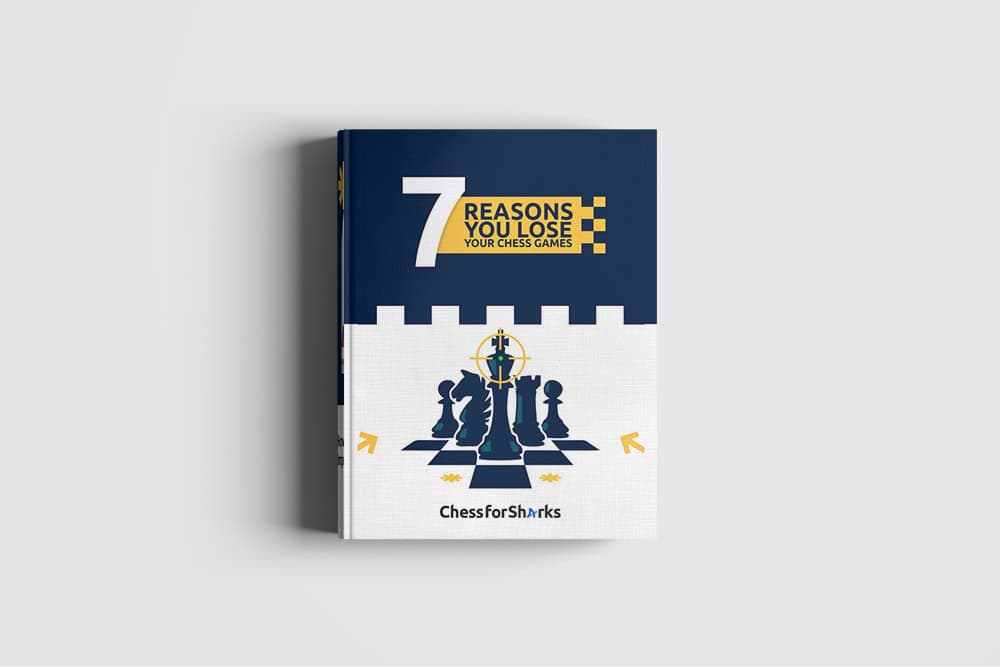



join the conversation